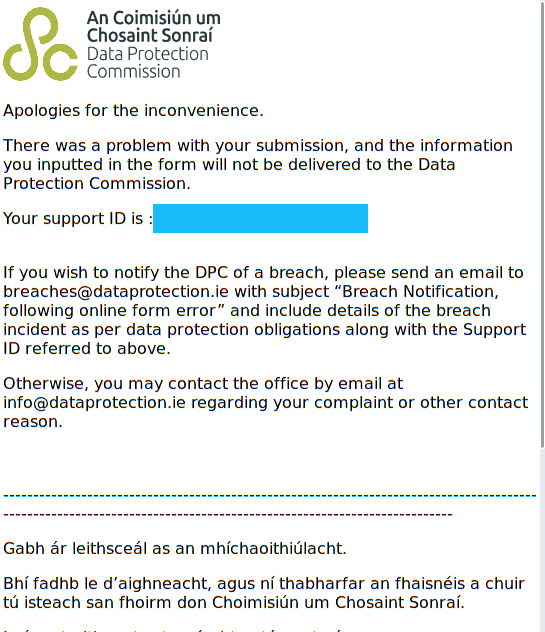Als Reaktion auf meinen Hilferuf gegen Google hat @ulif@chaos.social getrötet:
Vielleicht einfach mal unverbindlich bei der irischen "Datenschutzbehörde" nachfragen? Nicht als Beschwerde, sondern als einfache Anfrage. Denen müssen sie diese Daten ja eigentlich gemeldet haben.
Na schön. Das könnte interessant werden. Das erste Ergebnis einer duckduckgo-Anfrage nach „data protection ireland“. führt gleich zur data protection commission (bzw. Choimisiún um Chosaint Sonraí), https://www.dataprotection.ie/, und ich bekomme beim Draufklicken original das hier:

Keine GET-Parameter, kein POST-Payload, einfach nur https://www.dataprotection.ie/, und schon habe ich eine support ID. Oh wow. Interessanterweise ändert sich das auch nicht, wenn ich dataprotection.ie Javascript erlaube; mit einem Firefox (statt einem luakit) erscheint hingegen die Webseite, wie sich die Leute das wohl vorgestellt haben.
Wie kommt das? Ich curl-e mal eben die Seite und sehe schon recht weit oben:
<meta name="twitter:card" content="summary_large_image" /> <meta name="twitter:site" content="@dpcireland" /> <meta name="twitter:title" content="Homepage | Data Protection Commission" />
und noch ein paar mehr Zeilen Twitter-Service. Diese Leute sollten dringend mal ihrem Kollegen in Baden-Württemberg zuhören.
Immerhin kommen aber keine Webfonts von Google, und es laufen auf den ersten Blick auch keine externen Tracking-Dienste („Analytics“). Aber ich finde kein Refresh-Meta oder etwas anderes, das erklären könnte, warum luakit diese eigenartige Fehlermeldung ausgeliefert bekommen könnte, während an curl und firefox recht anständige Antworten gehen.
Leider macht auch dataprotection.ie die bedauerlichen Zwangs-Redirects auf https, so dass es nicht ganz einfach ist, zuzusehen, was mein Browser und der Webserver der IrInnen eigentlich miteinander ausmachen. Aber ich bin neugierig genug auf das, was da zwischen meinem Browser und dem dataprotection.ie-Server vorgeht, dass ich meinen mitmproxy auspacke und damit in die Kommunikation meines eigenen Computers einbreche[1].
Auf diese Weise sehe ich meinen Request:
GET https://www.dataprotection.ie/ Host: www.dataprotection.ie Accept: text/html,application/xhtml+xml,application/xml;q=0.9,*/*;q=0.8 User-Agent: Tracking is lame. Accept-Encoding: gzip, deflate Accept-Language: C Connection: Keep-Alive
Ah… richtig… ich bin ein wenig gemein mit der Sprach-Aushandlung in meinem normalen Browser und frage die Webseiten nach der Sprache C (was weniger gemein ist als es scheinen mag, aber das ist ein längeres Thema). Ein schnelles Experiment bestätitgt, dass es das ist, was den Drupal (das ist das Programm, das deren Webseite macht) der irischen Datenschutzbehörde getötet hat.
Wenn das noch oder wieder kaputt ist[2], wenn du das hier liest, ist eine einfache Kommandozeile, um das Problem zu reproduzieren:
$ curl -s -H "Accept-Language: C" https://www.dataprotection.ie/ | head -5 <!DOCTYPE html> <html lang="en"> <head> <title> Website error notice | Data Protection Commission </title> </head>
Aber egal, ich war ja eigentlich nicht hier, um Webseiten zu debuggen. Wichtig ist: Ich habe eine Mailadresse. Und das ist viel besser als das, was auf der normalen Webseite steht:

Echt jetzt? Papierpost ist ja schon noch sowas wie ein offener Standard, aber dann nur die proprietären, überwachungskapitalistischen Dienste Twitter, Instagram und Linkedin für Kontaktaufnahme anzubieten und nicht die offene Mail, das wäre auch für einen normalen Laden schon ein starkes Stück. Für eine Datenschutzbehörde… Na ja, ok, wir reden hier über die irische.
Immerhin steht in deren data protection statement:
If you wish to contact our Data Protection Officer in relation to the processing of your personal data by the Commission, you can do so by e-mailing dpo@dataprotection.ie.
Schön: immerhin gibts da eine Mailadresse, bei der ich mich beschweren könnte, aber ganz ehrlich: Anständige DatenschützerInnen sollten da bitte noch einen PGP-Schlüssel dazuschreiben. Jaja, ich weiß: das hier sind die irischen…
Ich sollte natürlich nicht so voreingenommen sein; nur weil die bisher ein Witz waren, heißt das ja nicht, dass sie das auch weiter sein werden, und so habe ich ihnen gerade eine Mail geschickt:
Dear DPO,
It seems your staff has already fixed it, presumably after I triggered some sort of alarm system while investigating the problem (in which case: apologies!), but your CMS until a few minutes ago produced error messages like the one on http://blog.tfiu.de/media/2022/ie-data-protection-breakage.png when queried with an
Accept-Language: Cheader. I'm reporting this partly to make sure the apparent fix wasn't a fluke. If it wasn't: kudos to your operations people to have noticed and fixed the problem so quickly.
While I'm here, can I also put forward the reason I'm contacting you in the first place?
You see, I'm trying to get rid of a Google account I created perhaps 15 years ago. To do that, Google tells me to log in. When I try that, Google asks for the e-mail address associated to the account (which is <withheld here>), then for the password. After I've put that in, Google sends a mail to the account with a confirmation code, which is perhaps not entirely unreasonable given I've steered clear of Google services requiring authentication for many years.
But even after entering that confirmation code, it will not let me in, requiring me to enter a telephone number. This is absolutely unreasonable, and I would be grateful if you could tell Google that much; given that Google does not know any telephone number associated to me, there is no way this information could fend off abuse. This is clearly a blantant attempt to skim off the extra piece of data.
I would normally not be bothering you with this obvious imposition, though; I would have liked to first take this to Google's data protection officer. However, I was unable to locate contact information in Google's privacy statements (I was served the German version), which I claim is in open violation of GDPR Article 13. So, could you
(a) tell Google to publish a proper e-mail contact address as part of their GDPR information? While I have to admit that the GDPR is not explicit about it, it is clear to me that Google's own web forms, in particular when they require Javascript and Captchas, or, even worse, a google id, are insufficient to fulfil Art 13 1 (b) GDPR.
(b) meanwhile, provide me with the contact e-mail of Google's data protection officer so I can take my issue to them myself?
Thanks,
(not Anselm Flügel)
Ich bin neugierig, wie es weitergeht. Lobend will ich schon mal erwähnen, dass der irische DPO offenbar keine automatisierten Empfangsbestätigungen („Wir werden uns Ihrem Anliegen so bald wie möglich widmen“) verschickt.
Fortsetzung folgt. Voraussichtlich.
Nachtrag (2022-08-31)
Ich muss das Lob zurücknehmen. Es gab doch eine (halb-) automatisierte Empfangsbestätigung, abgeschickt um 14:47 Lokalzeit in Dublin. Für ein Verfahren, das nur auf Computer setzt, ist das eine komische Zeit bei einer Mail, die am Vorabend um 19:17 MESZ rausging. Wirklich gelesen hat die Mail aber auch niemand. Das weiß ich schon, weil sie mich mit „To Whom It May Concern“ anreden, aber auch wegen der angesichts meiner Anfrage widersinnigen Empfehlung, ich möge mich doch an den Datenschutzbeauftragten „for that organisation“ wenden.
Weil Leute vielleicht später mal die Evolution des Kundendienstesisch des irischen DPO nachvollziehen wollen, belästige ich euch mit dem Volltext:
To Whom It May Concern,
I acknowledge receipt of your e-mail to the Data Protection Commission (DPC) .
In line with our Customer Service Charter, we aim to reply to the concerns raised by you within 20 working days, though complex complaints may require further time for initial assessment. In doing so, we will communicate clearly, providing you with relevant information or an update regarding your correspondence.
What can I do to progress my concern?
In the meantime, if your concern relates to processing of your personal data by an organisation (a “data controller”), or you wish to exercise your data protection rights (for example, access, erasure, rectification), you may wish to contact the data protection officer for that organisation in writing in the first instance. You may wish to forward copies of all written exchanges with the data controller to the DPC if you remain dissatisfied with the response you receive from them. You should send this documentation to info@dataprotection.ie and include the above reference number.
What if I have already contacted an organisation (“data controller”) about my concerns?
If you have already exchanged written correspondence with the data controller, and have not included this information with your initial contact with the DPC, you should send this documentation to info@dataprotection.ie quoting the case reference shown above.
What happens when I send the DPC additional correspondence or documents?
Please be advised that the Data Protection Commission does not issue acknowledgements for each item of follow up or supplementary correspondence received, but this correspondence will be included on the file reference above and assessed alongside your initial concern. Once this assessment has been carried out, a substantive response will be issued to you in due course.
This acknowledgement, and the reference number above, is confirmation that we have received your correspondence and that it will receive a response at the earliest opportunity.
Yours sincerely,
Alexandra X. [und noch ein Nachname]
[Ein paar Footer-Zeilen]
Is le haghaidh an duine nó an eintitis ar a bhfuil sí dírithe, agus le haghaidh an duine nó an eintitis sin amháin, a bheartaítear an fhaisnéis a tarchuireadh agus féadfaidh sé go bhfuil ábhar faoi rún agus/nó faoi phribhléid inti. Toirmisctear aon athbhreithniú, atarchur nó leathadh a dhéanamh ar an bhfaisnéis seo, aon úsáid eile a bhaint aisti nó aon ghníomh a dhéanamh ar a hiontaoibh, ag daoine nó ag eintitis seachas an faighteoir beartaithe. Má fuair tú é seo trí dhearmad, téigh i dteagmháil leis an seoltóir, le do thoil, agus scrios an t-ábhar as aon ríomhaire. Is é beartas na Roinne Dlí agus Cirt, na nOifígí agus na nGníomhaireachtaí a úsáideann seirbhísí TF na Roinne seoladh ábhair cholúil a dhícheadú.
Más rud é go measann tú gur ábhar colúil atá san ábhar atá sa teachtaireacht seo is ceart duit dul i dteagmháil leis an seoltóir láithreach agus le mailminder[ag]justice.ie chomh maith.
[Und dann nochmal so ein dämlicher Disclaimer auf Englisch]
Na dann: Bis in „20 working days“. Nach meiner Zählung ist das der 28. September. Um Ina Deter zu zitieren: Ein Tag im Kalender zum rot unterstreichen.
| [1] | Das würde ich übrigens für ein recht verlässliches Kennzeichen postmoderner Computersicherheit halten: Leute werden aus ihren eigenen Rechnern ausgesperrt, ganz wie bei Telefonen vom Apple- oder Android-Typ, in die Mensch gegen ihre Hersteller einbrechen muss, will mensch ein wenig Kontrolle über sie haben. |
| [2] | Ist es wahrscheinlich nicht; ich habe offenbar lange genug an dem Kram rumgefummelt, dass irgendwer bei der Firma, die die Seite für den DPO macht, aufmerksam geworden ist. Jedenfalls kommt jetzt gerade auch in meinem luakit die normale Webseite des irischen DPO. |
Zitiert in: Es ist wer daheim!
![[RSS]](./theme/image/rss.png)